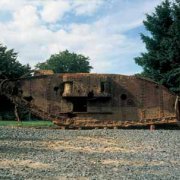Cimetière de la Route de Solesmes
Situé route de Solesmes, ce cimetière ne peut qu'évoquer le destin de cette ville occupée par les Allemands de 26 août 1914 au 9 octobre 1918, mais surtout la première bataille de Cambrai, du 20 novembre 1917 au 3 décembre, l'offensive allemande de mars 1918, cette deuxième bataille de Cambrai, dernière bataille sur la ligne Hindenburg, qui délivra finalement la cité en octobre 1918, la ville ayant alors été terriblement atteinte par les destructions.
Plus tard, la ville fut "adoptée" par le Bourg Comté de Birkenhead.
Ce cimetière avait été créé par les Allemands pendant leur occupation, à partir de mars 1917. Ils y avaient implanté quelques monuments et une croix de pierre. Et le 11 août 1918, le commandant Bavarois de la Place avait remis aux bons soins de la ville l'entretien du cimetière. Par la suite y fut transféré le cimetière militaire allemand qui se trouvait à Cambrai au cimetière Saint-Sépulcre.
Les tombes ont aujourd'hui été regroupées. S'y trouvent les corps de 10 685 Allemands, 192 Russes, 6 Roumains et 502 Britanniques.
Mémorial de Louverval
Sur la route Cambrai - Bapaume, à 13 km au nord-est de Bapaume, se trouve le Mémorial de Louverval.
Il commémore les 7 048 soldats britanniques et sud-africains qui moururent à la Bataille de Cambrai en novembre et décembre 1917 et dont les tombes ne sont pas connues.
La bataille de Cambrai marquée par une percée le 20 novembre, un arrêt sur positions le 22 et une contre-attaque allemande du 23 au 29 novembre, se solda par un gain de terrain mitigé mais apporta aux alliés de précieux enseignements tactiques et stratégiques. De leur côté, les Allemands avaient découvert que leur ligne de défense était vulnérable.
Le Mémorial, situé sur une terrasse à l'extrémité du cimetière militaire, a été conçu par H. Chalton Bradshaw, le sculpteur étant C.S. Jagger dont on peut admirer les deux bas-reliefs illustrant des scènes de combats.
Flesquières. Au cœur de la bataille de Cambrai
L'année 1917 a été une année terrible dans le cours de la Première Guerre mondiale pour tous les belligérants. A la fin de l'année, les Britanniques, voulant briser la ligne Hindenburg (système de défense des territoires occupés par les Allemands), décident de lancer une offensive au sud de Cambrai en engageant massivement des tanks. La bataille est impitoyable : les premiers combats sont autant de succès pour les troupes britanniques, sauf à Flesquières, mais très vite, les Allemands, d'abord désemparés, entament une vigoureuse contre-offensive.
Durant 15 jours, attaques et contre-attaques vont se succéder sans qu'aucune des deux armées ne remporte de succès décisif. Les pertes humaines sont énormes : 45 000 Britanniques et 55 000 Allemands sont tués, tandis que des villages entiers sont détruits. Pendant la Première Guerre mondiale, une nouvelle arme apparaît sur les champs de bataille : les tanks. Ils devaient servir à appuyer l'attaque de l'infanterie et à entraîner celle-ci à travers les lignes ennemies. Lors de la bataille en novembre 1917, le "Tank Corps" de la troisième armée britannique (476 chars au total) a été engagé afin de percer la ligne Hindenburg.
L'objectif de la bataille était la prise des positions stratégiques de la crête de Flesquières et du bois de Bourlon avant d'envisager la libération de Cambrai. A Flesquières, l'attaque britannique se heurta à une résistance acharnée des troupes allemandes qui parvinrent à détruire ou immobiliser de nombreux tanks. L'un d'entre eux, détruit, sera enfoui au printemps 1918 par les Allemands.
En novembre 1998, grâce à une poignée de passionnés, celui-ci est redécouvert. Aujourd'hui, vous pouvez retrouver ce vestige de guerre à Flesquières. A Cambrai, cette bataille est notamment perpétuée par le monument aux soldats des régiments de Cambrai, face à la porte de la citadelle, et par le monument du Souvenir Français où figurent tous les Cambrésiens morts aux combats de la Grande Guerre. Le cimetière de Louverval en constitue un important lieu de mémoire.

Caractéristiques :
- 26,5 tonnes
- 8,50 mètres de longueur
- 3,20 mètres de largeur
- chenilles d'une largeur de 52 cm
- 5 mitrailleuses de 13 000 à 30 000 cartouches
- Equipage de 8 hommes.
La crête
C'est sur la crête de Flesquières que se situe certainement l'épisode le plus important de la bataille de Cambrai.
Dominant la vallée, il nous est possible d'imaginer le point de départ de l'attaque britannique de 20 novembre 1917, sur un front d'environ 8 km, partant d'Havrincourt à Bonavis. A cet endroit, se trouvait un moulin. Pouvant servir de point de repère à l'artillerie britannique, il fut détruit par les Allemands. Aujourd'hui, la pose d'une table d'orientation représentant le système de défense de la ligne Hindenburg et l'édification d'un monument à la gloire des soldats morts sur-le-champ de bataille sont en projet.
Le blockhaus
Ce blockhaus allemand surélevé se caractérise par sa forme et son utilisation, car il servait de tour d'observation. En effet, son emplacement permettait de communiquer par le biais de signaux optiques avec Cambrai. Le poste d'observation était attenant au mur du parc du château. Aujourd'hui cet ensemble est en très bon état.
La tranchée
Une tranchée, fidèle reconstitution de l'époque, a été réalisée à l'occasion du tournage du documentaire "The Trench" par la BBC. La visite de ce site est possible sur rendez-vous en complément de celle du tank.
Les cimetières
Flesquières Hill British Cemetery
Dans ce cimetière, comme dans tous ceux de plus de 400 tombes, la Commonwealth War Graves Commission a édifié une "Pierre du Souvenir" sur laquelle est gravée l'inscription "Their Name Liveth For Evermore". Leur nom vit à tout jamais. Par ailleurs, le cimetière comporte 589 tombes connues et 332 inconnues. Auprès des Britanniques sont enterrés des soldats Néo-Zélandais et des Australiens ayant participé aux combats de la fin de la guerre.
Orival Wood British Cemetery
Ici repose la dépouille du célèbre poète anglais, le lieutenant Ewart Alan Mackintosh. Dans ce même site cohabitent les tombes des soldats canadiens et allemands tués dans le secteur de Flesquières.